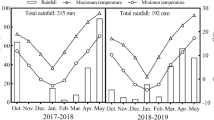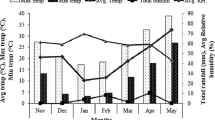Abstract
Zinc (Zn) is an important micronutrient for the growth and development of plant and humans, and dietary Zn shortage is a global wide nutritional problem. A field experiment was conducted to investigate the effects of foliar Zn application at different growth stages on grain yield, grain mineral nutrients and its relation to phytic acid content in spring wheat grown on Zn-deficient soil during the 2013–2014 growing season at Maragheh University research field, Iran. Results showed that foliar spray of zinc sulfate at different growth stages, in general, had non-significant effect on thousand grain weight and harvest index, while considerably increased grain yield, number of grains per spike, fertile spikelet per spike and plant height. Zinc and ascorbic acid contents in the grain consistently increased with the timing of the foliar Zn application and were highest at early grain filling stage. However, the timing of the Zn application had no effect on copper and phytic acid contents, but changed grain iron and manganese concentrations, and decreased phytate to Zn molar ratio of wheat grains. Results indicated that foliar Zn application at the booting + milking stages significantly increased agronomic traits, grain Zn content and bioavailability in wheat grown on Zn deficient alkaline soils, thereby improving the wheat grain’s nutritional quality for humans.


Similar content being viewed by others
References
Abdoli, M., Esfandiari, E., Mousavi, S. B., & Sadeghzadeh, B. (2014). Effects of foliar application of zinc sulfate at different phenological stages on yield formation and grain zinc contentt of bread wheat (cv. Kohdasht). Azarian Journal of Agriculture, 1(1), 11–17.
Aytac, Z., Gulmezoglu, N., Sirel, Z., Tolay, L., & Alkan Torun, A. (2014). The effect of zinc on yield, yield components and micronutrient contents in the seeds of safflower genotypes (Carthamus tinctorius L.). Notulae Botanicae Horti Agrobotanici Cluj-Napoca, 42(1), 202–208.
Bharti, K., Pandey, N., Shankhdhar, D., Srivastava, P. C., & Shankhdhar, S. C. (2013). Improving nutritional quality of wheat through soil and foliar zinc application. Plant, Soil and Environment, 59(8), 348–352.
Broadley, M. R., White, P. J., Hammond, J. P., Zelko, I., & Lux, A. (2007). Zinc in plants. New Phytologist, 173, 677–702. doi:10.1111/j.1469-8137.2007.01996.x.
Cakmak, I. (2002). Plant nutrition research: Priorities to meet human needs for food in sustainable ways. Plant and Soil, 247, 3–24. doi:10.1023/A:1021194511492.
Cakmak, I. (2008). Enrichment of cereal grains with zinc: Agronomic or genetic biofortification? Plant and Soil, 302, 1–17. doi:10.1007/s11104-007-9466-3.
Cakmak, I., Kalayci, M., Kaya, Y., Torun, A. A., Aydin, N., Wang, Y., et al. (2010a). Biofortification and localization of zinc in wheat grain. Journal of Agricultural and Food Chemistry, 58, 9092–9102. doi:10.1021/jf101197h.
Cakmak, I., Pfeiffer, W. H., & Mcclafferty, B. (2010b). Biofortification of durum wheat with zinc and iron. Cereal Chemistry, 87, 10–20. doi:10.1094/CCHEM-87-1-0010.
Chapman, H. D., & Pratt, P. F. (1961). Methods of analysis for soils, plants and waters. Riverside, CA: Division of Agricultural Sciences, University of California.
Chen, L., Yin, H., Xu, J., & Liu, X. (2011). Enhanced antioxidative responses of a salt-resistant wheat cultivar facilitate its adaptation to salt stress. African Journal of Biotechnology, 10, 16887–16896.
Erdal, U., Turan, M. A., & Taban, S. (2003). Effect of zinc application on growth and nutrient contents of corn grown in soils with different characters. Ankara University Journal of Agricultural Science, 9, 334–339.
FAO. (2012). Food Supply Database 2012 of Food and Agriculture Organization. http://faostat.fao.org/site/609/default.aspx#ancor. Accessed 15 Oct.
Farajzadeh Memari Tabrizi, E., Yarnia, M., Khorshidi, M. B., & Ahmadzadeh, V. (2009). Effects of micronutrients and their application method on yield, crop growth rate (CGR) and net assimilation rate (NAR) of corn cv. Jeta. Journal of Food, Agriculture and Environment, 7(2), 611–615.
Gibson, R. S., Donovan, U. M., & Heath, A. L. M. (1997). Dietary strategies to improve the iron and zinc nutriture of young women following a vegetarian diet. Plant Foods for Human Nutrition, 51, 1–16. doi:10.1023/A:1007966104442.
Haug, W., & Lantzsch, H. (1983). Sensitive method for the rapid determination of phytate in cereals and cereal products. Journal of the Science of Food and Agriculture, 34, 1423–1424. doi:10.1002/jsfa.2740341217.
Hotz, C., & Braun, K. H. (2004). Assessment of the risk of zinc deficiency in populations and options for its control. Food and Nutrition Bulletin, 2, 194–204.
ISO. (1986). Cereals-Determination of bulk density, called “mass per hectolitre”. International Organization for Standardization. ISO 7971-2.
Kutman, U. B., Yildiz, B., & Cakmak, I. (2011). Improved nitrogen status enhances zinc and iron contents both in the whole grain and the endosperm fraction of wheat. Journal of Cereal Science, 53, 118–125. doi:10.1016/j.jcs.2010.10.006.
Li, M., Yang, X. W., Tian, X. H., Wang, S. X., & Chen, Y. L. (2014). Effect of nitrogen fertilizer and foliar zinc application at different growth stages on zinc translocation and utilization efficiency in winter wheat. Cereal Research Communication, 42(1), 81–90. doi:10.1556/CRC.2013.0042.
Marschner, H. (1995). Mineral nutrition of higher plants (2nd ed.). Cambridge: Academic Press Inc. 890.
Mosanna, R., & Khalilvand-Behrozyar, E. (2015). Effect of zinc nano-chelate foliar and soil application and different growth stages on physiological performance of maize (Zea mays L.). Biological Forum-An International Journal, 7(1), 1327–1330.
Movahhedy-Dehnavy, M., Modarres-Sanavy, S. A. M., & Mokhtassi-Bidgoli, A. (2009). Foliar application of zinc and manganese improves seed yield and quality of safflower (Carthamus tinctorius L.) grown under water deficit stress. Industrial Crops and Products, 30, 82–92. doi:10.1016/j.indcrop.2009.02.004.
Okamura, M. (1980). An improved method for determination of L-ascorbic acid and L-dehydroascorbic acid in blood plasma. Clinica Chimica Acta, 130(3), 259–268.
Phattarakul, N., Rerkasem, B., Li, L. J., Wu, L. H., Zou, C. Q., Ram, H., et al. (2012). Biofortification of rice grain with zinc through zinc fertilization in different countries. Plant and Soil, 361, 131–141. doi:10.1007/s11104-012-1211-x.
Singh, A., & Singh Shivay, Y. (2015). Zinc application and green manuring enhances growth and yield in basmati rice (Oryza sativa L.). Indian Journal of Plant Physiology, 20(3), 1–8. doi:10.1007/s40502-015-0167-2.
Thiruppathi, M. K., Thanunathan, K., Prakashand, M., & Imayavaramban, V. (2001). Use of biofertilizer, phytohormone and zinc as a cost effective agro technique for increasing sesame productivity. Sesame and Safflower Newsletter, 16, 46–50.
Towo, E., Mgoba, C., Ndossi, G. D., & Kimboka, S. (2006). Effect of phytate and iron-binding phenolics on the contentt and availability of iron and zinc in micronutrients fortified cereal flours. African Journal of Food, Agriculture, Nutrition and Development, 6, 1–14.
Yang, X. W., Tian, X. H., Gale, W. J., Cao, X. Y., Lu, X. C., & Zhao, A. Q. (2011). Effect of soil and foliar zinc application on zinc content and bioavailability in wheat grain on potentially zinc deficient soil. Cereal Research Communication, 39, 535–543. doi:10.1556/CRC.39.2011.4.8.
Zadoks, J. C., Chang, T. T., & Konzak, C. F. (1974). A decimal code for growth stages of cereals. Weed Research, 14, 415–421. doi:10.1111/j.1365-3180.1974.tb01084.x.
Acknowledgments
The work reported here is part of the dissertation. Authors gratefully acknowledge the financial and technical support of the Maragheh University, Iran. We are grateful to Mr. M. Abdollahi from Maragheh University for technical assistance with the atomic absorption spectrophotometer analysis, Dr. A. Avanes from Maragheh University for his guidance with the phytic acid standard, and Dr. M. Saeidi from Razi University for technical assistance with the Elisa analysis.
Author information
Authors and Affiliations
Corresponding author
Rights and permissions
About this article
Cite this article
Esfandiari, E., Abdoli, M., Mousavi, SB. et al. Impact of foliar zinc application on agronomic traits and grain quality parameters of wheat grown in zinc deficient soil. Ind J Plant Physiol. 21, 263–270 (2016). https://doi.org/10.1007/s40502-016-0225-4
Received:
Accepted:
Published:
Issue Date:
DOI: https://doi.org/10.1007/s40502-016-0225-4




